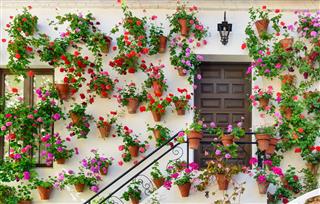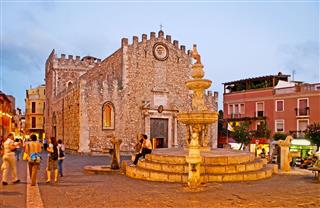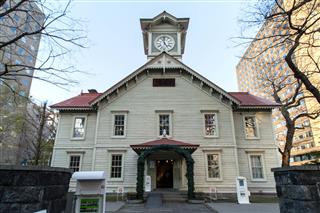
The term, Mediterranean architecture, is often used rather loosely to describe the various architectural styles from the Mediterranean region. In some instances, it is also refers to the Mediterranean Revival style. This Historyplex article is an attempt to shed light on what the term may actually encompass.
“I like the architecture. I like the Mediterranean look. I like the way all the elements tie together. This truly will be a destination center.”
― John Sundman
The Mediterranean region, also known as the Mediterranean Basin, comprises various lands, which are located along the Mediterranean coast. The region is vast, in that it spans across three continents―Europe, Asia, and Africa. Coastal regions from as many as 25 different countries and territories are contained in the Mediterranean Basin, and it is quite obvious that the history and culture of these regions has been largely influenced by the conditions, Mediterranean. When we speak of Mediterranean architecture, it needs to be noted that the term is as vast as the region itself. It is, in fact, an umbrella term that encompasses the architectural style(s) from the entire region, areas of which are prominently cut-off from each other. It, therefore, needs to be noted that there might be striking dissimilarities between the architectural styles of two, albeit neighboring areas.
The Scope
The Mediterranean Basin, as an area inhabited by humans, has a long history. Some of the most important and mightiest civilizations in the world have risen and flourished in the region. These include the Minoan, the Greek, the Roman, and the Byzantine civilizations, alongside others. Various architectural styles have prospered in this region, and have influenced structures the world over. Yet, it is indeed a pity that despite being a ‘hotspot’ of such a rich structural heritage, the Mediterranean region continues to be a loosely studied area, in terms of regional architecture and its evolution.
There is absolutely no doubt that the architecture of the Mediterranean coast has always had a number of local and regional influences, owing to which, the architectural style of one region is distinct from that of the other. But, at the same time, it is also true that there are certain features, which are common among the structures and edifices throughout the Mediterranean region, perhaps owing to the geographical location of the region, and/or its climatic conditions. In other words, the structure’s very location along the Mediterranean coast may demand certain architectural elements to be present in it. These elements then, go on to become the distinctive features of the style, such that they also tend to be incorporated, even in the adopted versions of the style, elsewhere in the world.
It is important to note that Mediterranean architecture, as we may know it today, might actually refer to the Mediterranean Revival architecture, a style that is primarily witnessed in some of the grandest structures across the United States of America, alongside some other European countries. These structures, essentially combine with the regional style(s), some of the most recognizable elements, found in buildings along the Mediterranean coast. Because these elements are often huge and prominent, they also become the most imposing features of these structures, so much so that Mediterranean becomes a brand, rather than a style of architecture.
An Overview
As mentioned before, the Mediterranean region is a unique and a distinct entity in itself. Since the distant antiquity, it has been a sea coast that has always been vulnerable to influences from the outer areas, by means of maritime trade, migrations, and so on. All these influences, combined with the regional styles, the natural environment, and a very peculiar take on life, have led to the formation of architectural style(s), the elements of which are very closely knit with nature. The structures which result, are thus, a combination of functionality as well as aesthetics. Following are some of the salient features of architecture of the Mediterranean coast:
- Architecture of the Mediterranean coast is characterized by the use of locally available building materials, in order to construct the structures. If we look at some of the early structures from this region, we realize that the building materials are available right in the vicinity, and that there is absolutely no sign of import of raw material from other regions, despite the fact that the region thrived on an ever-flourishing maritime trade.
- Genius loci, the protective spirit of the place, is regarded as an inherent aspect of each and every architectural work. The people of the Mediterranean region, especially the Greeks and the Romans, believed that every place bears a respective spirit that protects it from evils and dangers. So, when a structure is built on a place, this spirit becomes its inseparable part as well. In more realistic terms, the spirit refers to the natural surroundings of the place on which the structure stands. If these natural surroundings are exploited in a wrong way, the entire harmony of the place gets disturbed, and this may pose a danger to the structure in the future. So, Mediterranean architecture thrives on the fact that there has to be a balance and a unity between the natural and man-made elements.
- A typical Mediterranean structure as a whole, represents the unity of life. It is characterized by a complete unification of the interior and the exterior spaces; one opens up to the other, and/or surrounds it. It signifies how, much like the architectural forms, the human life is also an amalgamation of the inner and the superficial. In a nutshell, the Mediterranean structures tell us about the outlook of the people residing in the region, towards life.
- Structures of the Mediterranean region are simple and non-imposing in dimensions, perhaps in keeping with the enormity of the landscape and the sea. In other words, we see that a subtle balance is often maintained between the structure, and the entire landscape that surrounds it, such that the building seems like an inherent part of its surroundings, and not something that was built later on. In order to maintain this harmony, factors such as the dimensions and the overall atmosphere of the landscape, the shape, the light, the colors, etc., are taken into consideration.
- The presence of outside influences can be seen primarily in the Greek and the Roman structures, as also in a few scattered examples from Spain. This harmonious blend of the Eastern and the Western architectural elements makes the architecture of the Mediterranean region stand out in the world.

Elements of Traditional Mediterranean Architecture
In spite of the huge amount of disparities among the structures found along the Mediterranean coast, there are still certain architectural elements, which are common to all of them. The style that came to be known as Mediterranean Revival in the West from the 1920s has, in fact, borrowed a great deal from these very elements. All these elements can be regarded as the defining features of the structures of the Mediterranean coast. Let us have a look at some of them.
Low-pitched Roofs
Mediterranean structures typically have low-pitched roofs constructed with tiles, generally in the shades of red. While there are some earlier examples of roofs bearing one or two slopes, this element seems to have evolved and culminated in the form of a barrel roof.
High ceilings

These structures are often large spaces, which entertain a subtle play of light, shade, aromas, and air. Owing to this, they bear high-ceilings, perhaps almost about 20 to 25 feet high. This kind of height leads to an increase in the vertical space on the structure’s walls, thus, making it possible to make more number of openings.
Open Floor Plans

Traditional Mediterranean architecture dismisses the idea of closed and confined spaces, and gives way to more open plans, wherein there are not many defining bifurcations or boundaries. Therefore, the entire structure becomes one, single unit, in which there are minimum physical barriers. This sort of formation also enables a very soothing play of light and shade, alongside proper ventilation.
Stuccoed Exteriors

Stucco is a material, applied to the walls (and ceilings) of a structure, that hardens to form a very thick, solid layer. Alongside being durable, it is also a form of decorative coating. Stucco is applied on the exterior walls of Mediterranean structures, generally in pastel hues.
Arched Entrances
Although arches may not be found in each and every Mediterranean structure (there are regional variations), they are by far, the most well-known Mediterranean elements in the West. Arches, not only add to the aesthetic sense of the structure, but their use on the lower levels also help reinforce the upper levels. The arches often feature beautifully embellished keystones (wedge-shaped stones, placed at the apex of the arches), which make it possible to hold the arches in one position.
Patio

A patio is an outer space that adjoins the main structure, particularly residential in nature. Typically used for recreational activities or dining, this area is generally paved, and may or may not be roofed. It is commonly located between the structure, and its garden.
Courtyard

Courtyards exist everywhere in the Mediterranean, and in all possible shapes and variants. These are typically enclosed areas within the structures, but do not bear roofs. The structures, often open into the courtyard from their interior. Since historical times, courtyards have been serving numerous purposes such as cooking, sleeping, or even as places for keeping animals.
Garden

Situated directly in front of the main façade, Mediterranean gardens are large spaces which, though they add to the structure’s aesthetics, can also stand independent of it. Mediterranean gardens display a huge variety of fruits and flowers, which are cultivated in all the seasons. Plus, they also serve as private areas for leisure and pleasure.
Fountain

Water is viewed as a source of life in the Mediterranean region. Owing to this, fountain, as a continuous source of flowing water, forms an inevitable part of Mediterranean structures. It is generally made from cast stone, and is either one, two or three-tiered, with a circular basin at the top. It can be placed in the courtyard, in the patio, or in the garden, depending on personal preferences.
It can, therefore, be seen that a permanent contact with the outdoors is always maintained. And, this is the very factor that brings the structures from the Mediterranean region together under the umbrella term, ‘Mediterranean architecture’.
Mediterranean Revival Architecture




- In the late 19th and the early 20th centuries, America was introduced to a new architectural style, the Mediterranean Revival, inspired by several styles, originally belonging to the Mediterranean region.
- This new ‘architectural movement’ gained impetus in the 1920s and 1930s, when huge and imposing mansions were built, particularly in Florida and California.
- These palatial structures drew heavily from the seaside Mediterranean villas, which bore the typical elements, mentioned above.
- The kind of structures, which mostly came under the influence of this newly introduced style were hotels, residences, and commercial buildings.
- In California, the main proponents of Mediterranean Revival style were the architects, Bertram Goodhue, Sumner Spaulding, and Paul William. In Florida, the architects, Addison Mizner and August Geiger were foremost.
- Some of the famous American structures built in the Mediterranean Revival style include, Hayes Mansion, San Jose, California; Freedom Tower, Miami, Florida; Francis Marion Stokes Fourplex, Portland, Oregon; Pasadena City Hall, Pasadena, California; Breakers Hotel, Palm Beach, Florida; Santa Fe Railway Station, Santa Fe, New Mexico; and Beverly Hills City Hall, Beverly Hills, California.
Today, the United States and Europe has a number of grand, Mediterranean-style buildings which, apart from being astonishingly aesthetic in nature, are also major status symbols. It is absolutely overwhelming to note that a style(s), which is considered to be utilitarian in one part of the world, can attain such a position in the other.





